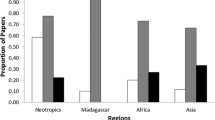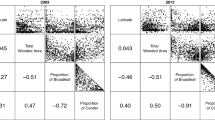Abstract
The identification of environmental factors linked to increased risk of local extinction often relies on inference from patterns of distribution. Yet for declining populations, the assumption of population equilibrium that underlies species distribution models is violated. Measures such as individual condition can provide a more direct indication of extinction risk, and can start to be detected before declines commence. We compared distribution-based and condition-based approaches to identifying factors affecting habitat suitability for an area-sensitive passerine, the eastern yellow robin Eopsaltria australis, in eastern Australia. We compared patterns of individual condition between robins and several common, more mobile species (Meliphagid honeyeaters and yellow thornbills Acanthiza nana). Robin presence was not affected by landscape context, but robins avoided sites with a more grassy ground layer. However, robins inhabiting landscapes with less remnant woodland had higher ratios of heterophils to lymphocytes in peripheral blood, indicating higher long-term stress. No clear spatial patterns of condition were detected for the more mobile species. Our findings suggest a hierarchical model of habitat suitability, whereby robins avoid grassy sites, but where they do occur are in poorest condition when inhabiting less-vegetated landscapes. We predict greater rates of local extinction of robins from such landscapes. The use of indicators of individual condition, in addition to distribution data, can unveil otherwise cryptic factors as important influences on habitat quality. As habitat occupancy does not always reflect habitat quality, exploring patterns in condition indices can complement species distribution modelling, potentially revealing threats to persistence before population declines have commenced.


Similar content being viewed by others
References
Araújo MB, Pearson RH (2005) Equilibrium of species’ distributions with climate. Ecography 28:693–695
Barrett GW, Ford HA, Recher HF (1994) Conservation of woodland birds in a fragmented rural landscape. Pac Conserv Biol 1:245–256
Barton K (2009) MuMIn: multi-model inference. R package version 0.12.2. http://r-forge.r-project.org/projects/mumin/
Benson TJ, Bednarz JC (2010) Relationships among survival, body condition, and habitat of breeding Swainson’s warblers. Condor 112:138–148
Berry L (2001) Edge effects on the distribution and abundance of birds in a southern Victorian forest. Wildl Res 28:239–245
Bjornstad ON, Falck W (2001) Nonparametric spatial covariance functions: estimation and testing. Environ Ecol Stat 8:53–70
Bonier F, Moore IT, Martin PR, Robertson RJ (2009) The relationship between fitness and baseline glucocorticoids in a passerine bird. Gen Comp Endocrinol 163:208–213
Bowen M, McAlpine CA, Seabrook L, House APN, Smith GC (2009) The age and amount of regrowth forest in fragmented brigalow landscapes are both important for woodland dependent birds. Biol Conserv 142:3051–3059
Brown DR, Sherry TW (2006) Food supply controls the body condition of a migrant bird wintering in the tropics. Oecologia 149:22–32
Burnham KP, Anderson DR (2002) Model selection and multimodel inference: a practical information-theoretic approach, 2nd edn. Springer, New York
Chevan A, Sutherland M (1991) Hierarchical partitioning. The American Statistician 45:90–96
Chown SL, Gaston KJ (2008) Macrophysiology for a changing world. Proc R Soc Lond B 275:1469–1478
Cooke SJ, O’Connor CM (2010) Making conservation physiology relevant to policy makers and conservation practitioners. Conserv Lett 3:159–166
Cushman S (2006) Effects of habitat loss and fragmentation on amphibians: a review and prospectus. Biol Conserv 128:231–240
Davis AK, Cook KC, Altizer S (2004) Leukocyte profiles of House Finches with and without mycoplasmal conjunctivitis, a recently emerged bacterial disease. EcoHealth 1:362–373
Davis AK, Maney DL, Maerz JC (2008) The use of leukocyte profiles to measure stress in vertebrates: a review for ecologists. Funct Ecol 22:760–772
Debus SJS (2006) Breeding and population parameters of robins in a woodland remnant in northern New South Wales, Australia. Emu 106:147–156
Department of Environment and Resource Management (2009) Land cover change in Queensland 2007–2008: a statewide landcover and trees study SLATS. Report. Department of Environment and Resource Management, Brisbane. URL: http://www.derm.qld.gov.au/slats/report.html
Elith J, Leathwick JR (2009) Species distribution models: ecological explanation and prediction across space and time. Annu Rev Ecol Evol Syst 40:677–697
Ellis RD, McWhorter TJ, Maron M (2012) Integrating landscape ecology and conservation physiology. Landsc Ecol 27:1–12
Fahrig L (2003) Effects of habitat fragmentation on biodiversity. Annu Rev Ecol Syst 34:487–515
Ford J (1979) Speciation or subspeciation in the yellow robins? Emu 79:103–106
Ford HA, Noske S, Bridges L (1986) Foraging of birds in eucalypt woodland in north-eastern New South Wales. Emu 86:168–179
Guisan A, Thuiller W (2005) Predicting species distribution: offering more than simple habitat models. Ecol Lett 8:993–1009
Higgins PJ, Peter JM (eds) (2002) Handbook of Australian, New Zealand and Antarctic birds. Volume 6: pardalotes to shrike-thrushes. Oxford University Press, Melbourne
Higgins PJ, Peter JM, Steele WK (eds) (2001) Handbook of Australian, New Zealand and Antarctic birds. Volume 5: tyrant-flycatchers to chats. Oxford University Press, Melbourne
Hinam HL, St Clair CC (2008) High levels of habitat loss and fragmentation limit reproductive success of reducing home range size and provisioning rates of Northern saw-whet owls. Biol Conserv 141:524–535
Hinsley S (2000) The costs of multiple patch use by birds. Landsc Ecol 15:765–775
Homyack JA (2010) Evaluating habitat quality of vertebrates using conservation physiology tools. Wildl Res 374:332–342
Howe RW (1984) Local dynamics of bird assemblages in small forest habitat islands in Australia and North America. Ecology 65:1585–1601
Irwin MT, Junge RE, Raharison J, Samonds KE (2010) Variation in physiological health of diademed sifakas across intact and fragmented forest at Tsinjoarivo, eastern Madagascar. Am J Primatol 72:1013–1025
Janin A, Léna J, Joly P (2011) Beyond occurrence: body condition and stress hormone as integrative indicators of habitat availability and fragmentation in the common toad. Biol Conserv 144:1008–1016
Jeltsch F, Moloney KA, Schurr FM, Köchy M, Schwager M (2008) The state of plant population modelling in light of environmental change. Perspect Plant Ecol Evol Syst 9:171–189
Johnson MD (2007) Measuring habitat quality: a review. Condor 1093:489–504
Johnson MD, Sherry TW, Holmes RT, Marra PP (2006) Assessing habitat quality for a migratory songbird wintering in natural and agricultural habitats. Conserv Biol 20:1433–1444
Johnstone CP, Lill A, Reina RD (2011) Response of the agile antechinus to habitat edge, configuration and condition in fragmented forest. PLoS ONE 6:e27158
Johnstone CP, Lill A, Reina RD (2012) Does habitat fragmentation cause stress in the agile antechinus? A haematological approach. J Comp Physiol B 182:139–155
Kearney M, Porter W (2009) Mechanistic niche modelling: combining physiological and spatial data to predict species ranges. Ecol Lett 12:334–350
Kurki S, Nikula A, Helle P, Lindén H (2000) Landscape fragmentation and forest composition effects on grouse breeding success in boreal forests. Ecology 81:1985–1997
Laurance SGW, Stouffer PC, Laurance WF (2004) Effects of road clearings on movement patterns of understory rainforest birds in central Amazonia. Conserv Biol 18:1099–1109
Lindenmayer DB, Cunningham RB, Donnelly CF (1993) The conservation of arboreal marsupials in the montane ash forests of the central highlands of Victoria, south-east Australia, IV. The presence and abundance of arboreal marsupials in retained linear habitats wildlife corridors within logged forest. Biol Conserv 66:207–221
Mac Nally R, Walsh CJ (2004) Hierarchical partitioning public-domain software. Biodivers Conserv 13:659–660
Maron M, Kennedy S (2007) Roads, fire and aggressive competitors: determinants of bird distribution in subtropical production forests. For Ecol Manage 240:24–31
Maron M, Lill A (2005) The influence of livestock grazing and weed invasion on habitat use by birds in grassy woodland remnants. Biol Conserv 124:439–450
Maron M, Lill A, Watson DM, Mac Nally R (2005) Temporal variation in regional-scale bird assemblages: how representative is a one-year snapshot? Austral Ecol 30:383–394
Marra PP, Holberton RL (1998) Corticosterone levels as indicators of habitat quality: effects of habitat segregation in a migratory bird during the non-breeding seasons. Oecologia 116:284–292
Mazerolle DF, Hobson KA (2002) Physiological ramifications of habitat selection in territorial male ovenbirds: consequences of landscape fragmentation. Oecologia 130:356–363
Morin X, Thuiller W (2009) Comparing niche- and process-based models to reduce prediction uncertainty in species range shifts under climate change. Ecology 90:1301–1313
Morrison EB, Lindell CA, Holl KD, Zahawi RA (2010) Patch size effects on avian foraging behaviour: implications for tropical forest restoration design. J Appl Ecol 47:130–138
Peig J, Green AJ (2009) New perspectives for estimating body condition from mass/length data: the scaled mass index as an alternative method. Oikos 118:1883–1891
Peterson AT (2003) Predicting the geography of species invasions via ecological niche modeling. Q Rev Biol 78:419–433
Queensland Herbarium (2003) 2001 Remnant vegetation communities and regional ecosystems and pre-clearing of all Queensland. Version 4.0. Queensland Herbarium, Brisbane
R Development Core Team (2010) R: a language and environment for statistical computing. R Foundation for Statistical Computing, Vienna, Austria. ISBN 3-900051-07-0, URL http://www.R-project.org
Radford JQ, Bennett AF, Cheers GJ (2005) Landscape-level thresholds of habitat cover for woodland-dependent birds. Biol Conserv 124:317–337
Robertson OJ, Radford JQ (2009) Gap-crossing decisions of forest birds in a fragmented landscape. Austral Ecol 34:435–446
Romero LM, Romero RC (2002) Corticosterone responses in wild birds: the importance of rapid initial sampling. Condor 104:129–135
Romero LM, Wikelski M (2001) Corticosterone levels predict survival probabilities of Galapagos marine iguanas during El Nino events. Proc Natl Acad Sci USA 98:7366–7370
Russell JS (1973) Effects of land smoothing on gilgaied brigalow soils on certain soil properties and plant growth. Trop Grasslands 7:209–218
Saunders DA, Hobbs RJ, Margules CR (1991) Biological consequences of ecosystem fragmentation: a review. Conserv Biol 5:18–32
Schulte-Hostedde AI, Zinner B, Millar JS, Hickling GJ (2005) Restitution of mass-size residuals: validating body condition indices. Ecology 86:155–163
Seabrook L, McAlpine C, Fensham R (2006) Cattle, crops and clearing: regional drivers of landscape change in the Brigalow Belt, Queensland, Australia, 1840–2004. Landsc Urban Plan 78:373–385
Sherry TW, Johnson MD, Strong AM (2005) Does winter food limit populations of migratory birds? In: Greenberg R, Marra PP (eds) Birds of two worlds. Johns Hopkins University Press, Baltimore, pp 414–425
Suorsa P, Huhta E, Nikula A, Jantti A, Helle H, Hakkarainen H (2003) Forest management is associated with physiological stress in an old-growth forest passerine. Proc R Soc Lond B 270:963–969
Suorsa P, Helle H, Koivunen V, Huhta E, Nikula A, Hakkarainen H (2004) Effects of forest patch size on physiological stress and immunocompetence in an area-sensitive passerine, the Eurasian treecreeper Certhia familiaris: an experiment. Proc R Soc Lond B 271:435–440
Titeux N, Dufrene M, Radoux J, Hirzel AH, Defourny P (2007) Fitness-related parameters improve presence-only distribution modelling for conservation practice: the case of the red-backed shrike. Biol Conserv 138:207–223
Turner M (2005) Landscape ecology: what is the state of the science? Annu Rev Ecol Evol Syst 36:319–344
Van Horne B (1983) Density as a misleading indicator of habitat quality. J Wildl Manage 47:893–901
Watson J, Freudenberger D, Paull D (2001) An assessment of the focal-species approach for conserving birds in variegated landscapes in southeastern Australia. Conserv Biol 15:1364–1373
Whigham PA (2000) Induction of a marsupial density model using genetic programming and spatial relationships. Ecol Model 131:299–317
Wikelski M, Cooke SJ (2006) Conservation physiology. Trends Ecol Evol 21:38–46
Zanette L, Doyle P, Trémont SM (2000) Food shortage in small fragments: evidence from an area-sensitive passerine. Ecology 81:1654–1666
Acknowledgments
This work was made possible with funding from an Early Career Researcher Award from The University of Queensland. We thank David Watson and Todd McWhorter for discussions which helped crystallize this work, and Clive McAlpine and Erik Johnson for valuable comments on an earlier draft. The research was conducted under animal ethics approval no. GPA/017/09 from The University of Queensland.
Author information
Authors and Affiliations
Corresponding author
Rights and permissions
About this article
Cite this article
Maron, M., Goulding, W., Ellis, R.D. et al. Distribution and individual condition reveal a hierarchy of habitat suitability for an area-sensitive passerine. Biodivers Conserv 21, 2509–2523 (2012). https://doi.org/10.1007/s10531-012-0314-2
Received:
Accepted:
Published:
Issue Date:
DOI: https://doi.org/10.1007/s10531-012-0314-2




